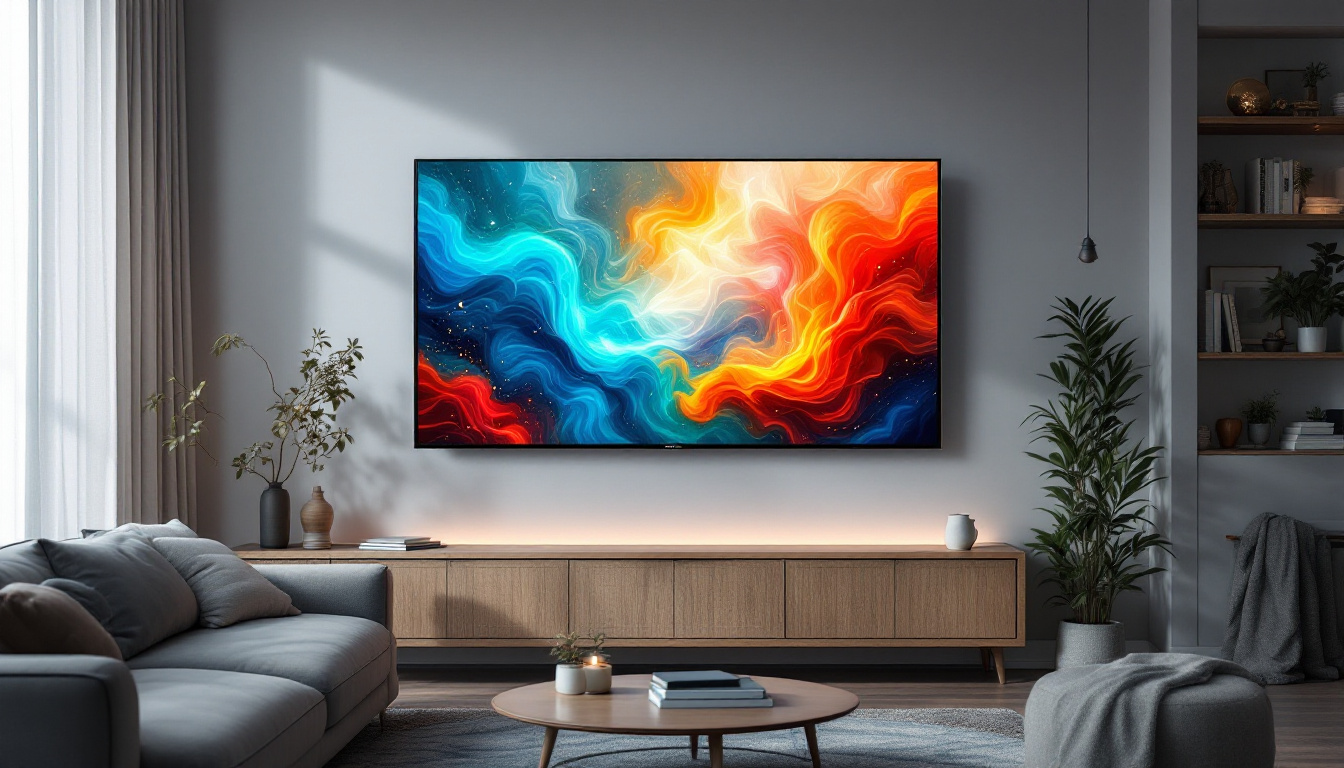First Plasma TV: LED Display Explained
The evolution of television technology has seen remarkable advancements over the past few decades. Among the most significant milestones in this journey was the introduction of plasma TVs, which revolutionized the way we experience visual media. This article delves into the history of plasma TVs, their unique features, and how they compare to modern LED displays.
The Birth of Plasma Technology
Plasma display technology emerged in the late 1960s, but it wasn’t until the late 1990s that it became commercially viable for consumer televisions. The first plasma TVs were introduced by several manufacturers, creating a buzz in the electronics industry. These televisions offered a level of picture quality and screen size that was previously unattainable. The initial models were often bulky and expensive, limiting their appeal to early adopters and tech enthusiasts. However, as production techniques improved and costs decreased, plasma technology began to find its way into more homes, marking a significant shift in how consumers experienced visual media.
How Plasma Displays Work
Plasma displays utilize small cells filled with a mixture of noble gases, primarily neon and xenon. When an electric current is applied, these gases become ionized and produce ultraviolet light, which then excites phosphors coated on the inside of the screen, creating visible light. This technology allows for deep blacks and vibrant colors, making plasma TVs particularly appealing to home theater enthusiasts. The ability to achieve a high contrast ratio means that viewers can enjoy a more immersive experience, especially in dark scenes where subtle details can be more easily discerned. Additionally, the uniformity of color across the screen enhances the viewing experience, making it suitable for a variety of content, from movies to video games.
The Rise in Popularity
During the early 2000s, plasma TVs gained immense popularity due to their large screen sizes and superior color reproduction. They were particularly favored for watching movies and sports, as they provided a wider viewing angle than traditional LCDs. The ability to display fast-moving images without blurring made them a preferred choice for many consumers. As competition increased, manufacturers began to innovate further, introducing features such as high-definition resolution and improved energy efficiency. This not only made plasma TVs more appealing but also helped to establish them as a staple in modern living rooms. The excitement surrounding plasma technology was palpable, with consumers eagerly discussing the latest models and features, and retailers often showcasing them as the centerpiece of their electronics displays.
Key Features of Plasma TVs
Plasma TVs were celebrated for several key features that set them apart from their LCD counterparts. Understanding these features helps to appreciate the technology’s impact on the television landscape.
Picture Quality
One of the standout features of plasma TVs is their exceptional picture quality. The ability to produce deep blacks and vibrant colors made them ideal for cinematic experiences. Unlike LCDs, which often struggled with contrast ratios, plasma displays excelled in providing a more immersive viewing experience, particularly in dimly lit environments. This capability was largely due to the individual control of each pixel, allowing for a more nuanced color palette and superior gradation in shades. As a result, viewers could enjoy films and shows as the creators intended, with lifelike images that popped off the screen.
Wide Viewing Angles
Another advantage of plasma technology is its wide viewing angles. Plasma screens maintain consistent color and brightness levels even when viewed from the side. This feature is particularly beneficial for larger gatherings, where multiple viewers may be seated at different angles relative to the screen. Unlike some LCDs that tend to wash out or distort colors when viewed off-axis, plasma TVs deliver a uniform viewing experience, making them a popular choice for home theaters and family rooms. This characteristic also enhances the enjoyment of multiplayer gaming sessions, as everyone can see the action clearly without needing to huddle directly in front of the screen.
Fast Refresh Rates
Plasma TVs also boasted fast refresh rates, which minimized motion blur during fast-paced scenes. This made them particularly suitable for action movies and sports broadcasts, where clarity and detail are crucial. The technology allowed for a smoother viewing experience, enhancing the overall enjoyment of dynamic content. Additionally, the rapid pixel response times contributed to a more fluid representation of movement, making it easier for viewers to track fast-moving objects on screen. This responsiveness was a significant draw for sports enthusiasts and gamers alike, as it ensured that they would not miss a moment of the action, whether it was a last-minute goal or a thrilling chase scene.
Moreover, plasma TVs were known for their ability to handle high-definition content exceptionally well. With the rise of HD broadcasting and Blu-ray technology, the rich color depth and high contrast ratios of plasma screens allowed viewers to fully appreciate the enhanced detail and clarity that these formats offered. The combination of high refresh rates and superior color reproduction made plasma TVs a favorite among videophiles who sought the best possible home viewing experience. Despite their eventual decline in popularity with the advent of OLED technology, plasma TVs left an indelible mark on the evolution of display technology, showcasing what was possible in terms of picture quality and viewer engagement.
Comparing Plasma and LED Displays
As technology advanced, LED displays began to dominate the market, leading many consumers to question the differences between plasma and LED technologies. Each has its own strengths and weaknesses, which are essential to consider when choosing a television.
Brightness and Energy Efficiency
LED displays, which are essentially LCDs enhanced with LED backlighting, tend to be brighter than plasma TVs. This makes them more suitable for well-lit rooms. Additionally, LED displays are generally more energy-efficient, consuming less power than plasma TVs. This efficiency has become a significant factor for environmentally conscious consumers.
Longevity and Burn-In Issues
Plasma TVs are known to suffer from burn-in, a phenomenon where static images can become permanently etched into the screen if displayed for extended periods. This issue is less prevalent in LED displays, which do not exhibit this problem. Furthermore, LED TVs typically have a longer lifespan, making them a more durable option for consumers.
Cost and Value
When plasma TVs were at their peak, they were often more expensive than their LCD counterparts. However, as technology progressed, prices for both types of displays have become more competitive. Today, consumers can find a range of options at various price points, making it essential to weigh the features against the cost to determine the best value.
The Decline of Plasma TVs
Despite their initial success, plasma TVs began to decline in popularity as LED technology advanced. Several factors contributed to this downturn, leading to the eventual discontinuation of plasma production by major manufacturers.
Market Trends and Consumer Preferences
As consumers began to prioritize energy efficiency and brightness, LED displays gained a significant edge in the market. The demand for thinner, lighter televisions also played a role in the decline of plasma technology. LED TVs are generally more compact, making them easier to mount on walls or fit into smaller spaces.
Manufacturers’ Shift in Focus
In response to changing consumer preferences, major manufacturers shifted their focus from plasma to LED technology. This transition was fueled by the need to innovate and meet the demands of a rapidly evolving market. As a result, plasma TVs became increasingly difficult to find, and production ceased altogether by the mid-2010s.
The Legacy of Plasma Technology
While plasma TVs may no longer be in production, their legacy continues to influence the television industry. The advancements made during the era of plasma technology laid the groundwork for future innovations in display technology.
Impact on Modern Displays
The rich colors and deep blacks achieved by plasma technology have inspired the development of new display technologies, such as OLED (Organic Light Emitting Diode). OLED displays offer similar advantages, including excellent color reproduction and wide viewing angles, while also addressing some of the limitations associated with plasma technology.
Appreciation Among Enthusiasts
Many home theater enthusiasts still hold plasma TVs in high regard for their picture quality and performance. Collectors often seek out older plasma models, appreciating their unique characteristics and the nostalgia they evoke. This appreciation serves as a testament to the impact plasma technology had on the evolution of television.
Conclusion
The journey of plasma TVs from their inception to their decline is a fascinating chapter in the history of television technology. While LED displays have taken center stage in recent years, the contributions of plasma technology cannot be overlooked. From their superior picture quality to their wide viewing angles, plasma TVs set a high standard that continues to influence modern display technologies.
As consumers navigate the ever-changing landscape of television technology, understanding the strengths and weaknesses of each type of display is crucial. The legacy of plasma TVs serves as a reminder of the rapid advancements in technology and the continual pursuit of a better viewing experience.
In the end, whether one prefers the vibrant colors of plasma or the brightness of LED, the evolution of television technology reflects a broader trend of innovation and improvement in how we consume visual media. As new technologies emerge, the quest for the perfect display continues, ensuring that the legacy of plasma TVs will always hold a special place in the hearts of enthusiasts and casual viewers alike.
Discover the Future of Visual Display with LumenMatrix
As we celebrate the innovative legacy of plasma TVs and their influence on current display technologies, the quest for impeccable visual quality and immersive experiences continues. Embrace the future with LumenMatrix, a pioneer in LED display technology. Our extensive range of solutions, including Indoor and Outdoor LED Wall Displays, Vehicle LED Displays, LED Poster Displays, and more, are designed to elevate your visual storytelling and captivate your audience. Experience the pinnacle of clarity, vibrancy, and dynamic presentation with our cutting-edge LED displays. Check out LumenMatrix LED Display Solutions today and transform your visual communication into an unforgettable experience.































